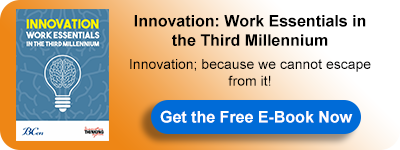How to Foster Innovation at Work - For Management
Creative ideas are not rare to find, your team can be coming up with new ideas every day, but you just don’t know about it. In order for those ideas to turn into real innovation, you must provide them with the right environment to flourish. Here are some things you can do, as a management, at your company to foster innovation:
1. Reduce daily stress
People who are under a lot of pressure and burdened with daily tasks, hardly have the mental capacity to look forward or be creative. One of the first things you can do is make sure your employees are not loaded, and that your company is well staffed in terms of number.
2. Encourage long-term thinking
Hold monthly or bi-weekly meetings for the sole purpose of discussing the future. Share the company vision with your team - if it’s not already shared - and ask them questions on how they think this vision can be attained. Keep a record of all ideas and allow discussions to happen on a few of them. The term “forward thinker” - which now refers to innovative people or companies - actually means to look toward and plan for the future.
3. Hold competitions
One of the most effective ways to get people excited about things is if they compete with one another. Instead of a regular meeting or brainstorming session, try holding a competition where cross functional teams are put together to think of a solution to a problem or come up with the most viable idea for a new product or service. Reward the winning team with recognition and real rewards - not necessarily financial - to motivate people to give it their all.
➔ In order for this to create real outcomes, you need to be prepared to put into action the winning idea (and some of the other ideas as well) - and include the relevant team members. This way, people will put their heart into it, as they will know they are heard and taken seriously.
➔ These types of competitions could be held yearly, quarterly, or even monthly, depending on the type/size of mission you will have people work on.
4. Lead accountability for problems
When problems occur - and they will often occur - instead of wasting precious time trying to pinpoint who is to blame or what caused the problem, lead your teams to look forward and figure out how this problem can be solved, and how they can prevent it from happening again. Don’t offer solutions yourself, but encourage teams to think for themselves and come up with different solutions. This also shows people that they are allowed to make mistakes, as the road to innovation is full of them.
➔ The idea of a competition could be implemented here, especially when you have time on your hands.
5. Push for customer focus
If we build on the definition of innovation mentioned earlier; “Staying Relevant,” and ask ourselves “staying relevant to what?,” the single most accurate answer would obviously be; the customer. Customer-centricity requires a huge shift - first in mindset - then in every single function in the company. It is a strategic move that requires months to effectively implement. However, there are small ways you can get employees to think like the customer.
❖ Give employees time to be a customer to the company, to get the full experience of a regular customer. They can go to a shop, check the prices and stand in line to buy, or go through the service online or at the premises (ex: a bank or a car service center). This should be time counted in their working hours, not extra work that they would be reluctant to do.
❖ Ask teams to firmly dedicate a few hours of their week to work on their own new ideas and projects, whether as individuals, pairs, or full small teams. This would help employees unplug from their day-to-day work and look forward to creating something exciting with their teammates. Those ideas and projects could very well be an improvement in internal processes or the office interior, but it still serves a type of customer - the internal one.
6. Communicate
The simplest and most straightforward way to affect change in your company - supported of course by other activities like the above - is to communicate with your people honestly and directly. Plan an internal campaign with your top management to explicitly deliver the message to everyone in the company that you are adopting, encouraging, and rewarding innovation. You can do it through a combination of general/departmental meetings, email campaigns, motivating wall art, and other channels that would constantly remind employees of the direction you are taking.
For more about this topic, download our latest book "Innovation: Work Essentials in the Third Millennium" for FREE:
